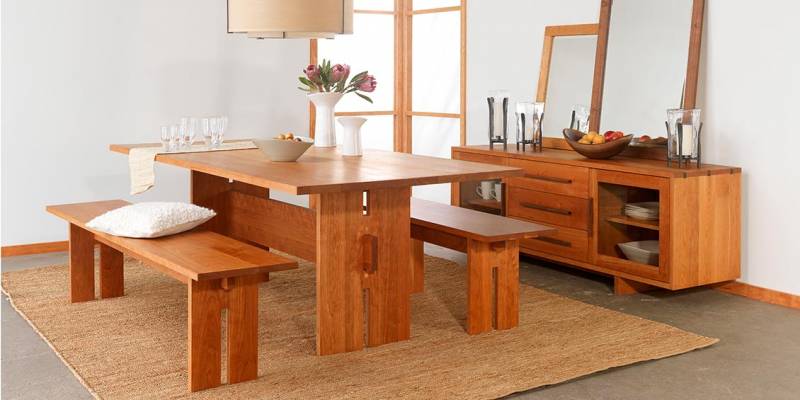At Vermont Woods Studios, we're all about furniture that stands the test of time—crafted sustainably, locally, and with purpose. That’s why it’s important to understand the difference between "modern" and "contemporary" design. Though the terms are often used interchangeably, they actually reflect two very distinct perspectives on style and form.
We like to think of the difference between modern and contemporary design as follows: modern design will never change, while contemporary design is always being redefined.
What is Modern Design?
 Modern design refers to aesthetic movements from the early to mid-20th century, especially Art Deco and Mid-Century Modern. Think clean lines, minimalist silhouettes, and an emphasis on function. Materials like wood, leather, and stone are common, often complemented by earthy tones—brown, olive, and rust—though bold accents may add interest. Today, modern design endures because its clarity and purpose continue to resonate.
Modern design refers to aesthetic movements from the early to mid-20th century, especially Art Deco and Mid-Century Modern. Think clean lines, minimalist silhouettes, and an emphasis on function. Materials like wood, leather, and stone are common, often complemented by earthy tones—brown, olive, and rust—though bold accents may add interest. Today, modern design endures because its clarity and purpose continue to resonate.
Mid-Century Modern Design Characteristics

Mid-Century Modern design was Influenced by Danish Modernism and Bauhaus. It peaked in the 1950s and 1960s—hence its name.
- Minimalist designs with a warm aesthetic
- Organic shapes often with softer curves and refined lines
- Wood is the most common material
- Uses neutrals and select bold colors as accents
- Utilizes the philosophy, “Form follows function.”
What is Post-Modernism? A Bridge Between Modern and Contemporary
Post-modernism ruled in the 1970s and 1980s, and it was unlike any design style that came before it. Although modern style is said to have paved the way for post-modernism, they are worlds apart.
For example, while Mid-Century Modern often strategically uses bold pops of color, post-modernism doesn’t bother. And the practicality of valuing function that modern design is so well-known for? Post-modernism takes the opposite approach.
Contemporary Design History
 Contemporary design is dynamic—it evolves with the times. Emerging in the 1970s, contemporary trends tend toward neutral palettes—think whites, blacks, grays—with occasional pops of bright accent colors. It often incorporates modern materials like glass, metal, and concrete and values form just as much as function, making it an ever-adaptable approach.
Contemporary design is dynamic—it evolves with the times. Emerging in the 1970s, contemporary trends tend toward neutral palettes—think whites, blacks, grays—with occasional pops of bright accent colors. It often incorporates modern materials like glass, metal, and concrete and values form just as much as function, making it an ever-adaptable approach.
Modern vs. Contemporary
Modern design is grounded in natural materials and a warm, earthy palette—woods, leathers, and soft neutral tones like browns, olives, and rusts. It’s rooted in mid-20th century aesthetics, particularly the Mid-Century Modern and Art Deco movements, and emphasizes clean lines and purposeful simplicity.
Contemporary design, on the other hand, is ever-evolving. It embraces sleek materials like glass, metal, and concrete, and typically features a more restrained, monochromatic palette—whites, blacks, and grays—accented by occasional bold pops of color.
While both styles share a love for minimalism and clean geometry, modern design remains consistent and historically anchored, whereas contemporary design adapts to reflect the style and mood of the present moment.
Why the Difference between Modern and Contemporary Matters to Us
At Vermont Woods Studios, these distinctions reflect our commitment to blending timeless craftsmanship (modern design) with relevant, thoughtful styling (contemporary design). We believe furniture should be both enduring and appropriate for today’s living spaces.
By working with local Vermont artisans and responsibly sourced hardwoods, we offer pieces that feel rooted in classic design traditions yet look perfectly at home now and into the future.
Ready to explore your style? Discover furniture that balances lasting quality and current style—crafted with care, purpose, and sustainability.



